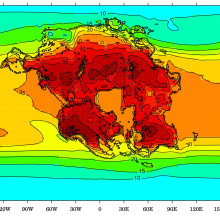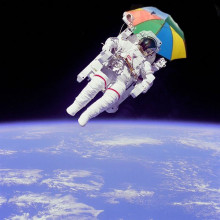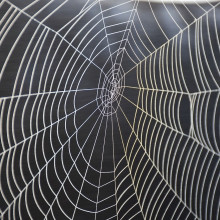In this episode of The Naked Scientists, A future proof covid jab that combats variants that don’t even exist yet. Reassuringly for theoretical physics, signs that antimatter does obey the rules of gravity, and why one doomsday scenario is predicting we’ll all be wiped out in 250 million years time, when plate tectonics give us a new supercontinent.
In this episode

- Future-proof vaccine for COVID variants down the line
Future-proof vaccine for COVID variants down the line
Sneha Vishwanath & Jonathan Heeney, University of Cambridge
As coronavirus infection rates climb again, a future-proof coronavirus vaccine that can protect against variants of the virus that don't even exist yet - is welcome news. Jonathan Heeney and Sneha Vishwanath have used the genetic sequences collected from the viruses that circulated during the pandemic to spot parts of the virus structure that have never changed: they’re said to be "conserved". The virus is obliged to keep these components the same because they carry out critical functions. Altering them would disable the virus, so in this respect, they're an Achilles Heel, that will be present in all variants of the virus, including those that crop up in future. But the virus normally keeps these structures hidden from our immune systems, for obvious reasons, so most people don't produce an immune response against them following a natural infection. But what the Cambridge duo have done is to glue a slew of these structures together into a cocktail that the immune system can see, producing a powerful response that, in their test animals, remains effective for at least two years and works against the multiple variants of the virus they've tested. It's now in early clinical trials…
Jonathan - The problem is that viruses change faster than we can manufacture vaccines and the vaccine is way behind the virus. And now we've seen that throughout the COVID pandemic with all the waves of variants. So we needed a solution to get ahead of the virus.
Sneha - We sort of assembled all the information that is out there for viruses which behave or look like the current coronaviruses and then look into what is common between all these viruses and what are the regions which would induce a good protection or an immune response against these sets of viruses.
Chris - So these are bits of the virus that are always there. It doesn't change them. So if you hit them with some kind of immune response, you should hopefully work against what's circulating now, but what hasn't even evolved yet.
Jonathan - Exactly. We're trying to target the Achilles heel, that part of the virus that is essential for binding to its receptor, or replicating, or exiting the cell. Those are key structures like the door handle that cannot be changed for this particular virus.
Chris - You are going then for bits of the virus that don't change as it evolves. If I catch it once, why do I not make a response against those things and then get protection for life?
Jonathan - Some lucky people do make those responses. That would explain why not everybody in the household would get ill at the same time despite their common exposure.
Chris - I'm with you. So some people do make responses against these bits of virus, but the majority don't. And you are coming up with ways to make the majority make responses against the bits that most people wouldn't but which are always going to be there.
Sneha - Exactly, what we are trying to do is making sure that each and every individual sees that conserved part first so that it generates a better immune response against that.
Chris - How do you know what those bits are?
Jonathan - We are fortunate to have a huge amount of sequence data. As you know, this country and many other countries, we're following these viruses by sequencing them and we get this data and we line it up and compare where those changes are happening and we identify those regions which aren't being changed and those are the regions that we target.
Chris - And how do you turn the identification of this region and this region and this region, which are those Achilles heels, into a potential vaccine?
Sneha - So once we identify these regions, these genes specifically that act like a recipe for the vaccines when it gets expressed it can form that protein and it can induce that immune response.
Chris - Do you put the gene into sort of cells in culture then to make the protein the bit of the viral coat or the innards of the virus that you want to turn into a vaccine?
Jonathan - That's one of the first steps in the process, correct. So we take the code and then we test those in cells to see if we've got the right structures.
Chris - And then how do you know if it's going to work as a vaccine?
Sneha - So once we check it's getting expressed in cells, we basically immunise different animals with these particular vaccines which express our genes and then we make sure we check whether they are generating appropriate immune responses or not.
Chris - These animals, do you then try and infect them with coronavirus infection or do you collect the antibodies that they make and see how they work?
Jonathan - We first collect the antibodies that they make and check to make sure that those antibodies will block variant A, B, C right down to Omega. And we've shown that we can protect animals with these vaccines.
Chris - How good are they?
Sneha - They're quite good. <laugh>
Chris - Only quite <laugh>. Jonathan's rolling his eyes going, 'no, they're much better than that.' <laugh>
Sneha - Yeah, they're much better than what we have right now currently in the market because it targets just not one virus. It also targets multiple viruses. So giving us better protection than what's out there in nature right now.
Jonathan - Everybody's heard of antimicrobial resistance and you know that if you use penicillin for instance, there's a good chance that a bacteria may get around that penicillin. And to treat people with multiple complex infections, we'll use combinations of drugs. Well we use that similar strategy with our vaccines. So we'll add in Achilles heel A, Achilles heel B and Achilles heel C, all into our vaccine so that we've locked as many doors as possible.
Chris - That's neat. So rather than just target one thing because you've got a whole bunch of vulnerabilities and you hit them all at once in the same cocktail, the chances of it being able to change all of them all at once, even if it could, is so remote that it's not going to.
Jonathan - Exactly. And that's our strategy now. So we are going to take these structures and our new generation of vaccines has got those cocktails in them.
Chris - One of the problems has been the longevity of the response. We've seen people get vaccinated and then within months they appear to be infectable again. How long lasting is the response that you get to these vaccines when you put these into your test animals?
Sneha - In test animals, it does show a good response up to like 24 months in mice. But I think that needs to be tested in humans.
Chris - Do you think this is scalable? Practical? Is this going to become the next thing on the market? This sounds promising.
Jonathan - We're hoping in order to get it to the market, we need a commitment, a long-term commitment because it's expensive. And to do that you need investment from pharmaceutical companies. So we'll be looking to partner with big pharma to help us get those studies done.
Chris - What's the timeline now? Now you've got this initial proof of concept. How long before we're able to realistically deploy this?
Sneha - We have started the phase one study, so once we get the results from that, I think maybe another two to three years. If everything goes in favour.

Mammals could go extinct in 250 million years time
Alexander Farnsworth, University of Bristol
Scientists at the University of Bristol have said that heat is likely to eliminate nearly all mammals in around 250 million years time. By modelling the development of the Earth’s atmosphere, the movement of tectonic plates, and the activity of the Sun, it has been predicted that our continents will converge to form one huge land mass - which has been dubbed Pangaea Ultima. It’s predicted that temperatures on this supercontinent could exceed 50 degrees Celsius. So, what should we expect? The study’s lead author is Dr Alexander Farnsworth.
Alexander - There are three really main processes here that we want to kind of really try and understand what's going on. First you have all these big continents now merging together into this one big supercontinent. And the first thing to really take into account here, and it's really important, is this big supercontinent is essentially centred on the equator. So most of the land mass is already in the hot tropics. On top of this, you then get this big seasonality effect that you get with these sorts of big supercontinents because you have these big interior regions but become very, very hot and dry. And this happens because the further away you go from the oceans, the less you get the influence of those oceans and oceans tend to, for in the case of the UK, it actually keeps us warmer in the winters because it's transported a lot of heat northward and that heat tends to stay in the oceans a lot longer than, say, on the land surface which dissipates that heat quite quickly. So the further away you go from these oceans, the less of an influence it can have. Kind of akin to almost what you might see in the middle of Canada and America or middle of Russia where you can have very, very hot, hot summers. The next factor we kind of really need to take into account is what is the sun doing? And we can kind of predict exactly the trajectory of how much brighter the sun will be in about 250 million years. So it's in the general region about 2.5% brighter. So two and a half percent more energy is gonna be emitted by the sun. Then we have this sort of third factor going on and it's what CO2 is doing. When these sort of plate tectonics start to converge and they start to kind of hit and bang into each other and plates subduct under one another, it has an impact on the mantle. This creates a lot of volcanism and that volcanism, as we know, can spew up a lot of CO2 over a long time period into the atmosphere. And what we're predicting is we're looking at, you know, CO2 values that might be up to double what we see today.
Will - Really is a horrifying sounding future. That being said, there are places on Earth currently that hit 50 degrees centigrade not infrequently. They are not ecological paradises. So in the future, which animal groups are going to be hit the hardest by this?
Alexander - We know from our study that we think mammals are certainly going to be hit quite hard. Now a question you might want to ask is, okay, we know in the past it was much, much warmer, much, much hotter than it is today. So why didn't mammals go extinct then? And this is generally again down to where the supercontinent is situated in these very warm tropics. Now most mammals in the past, they've been able to escape a lot of these hot temperatures by moving towards the poles into these other regions, which would be much cooler, which you couldn't do in the future because you don't have these polar regions with land surface anymore. So that's already taken away, that sort of refugia from the heat. So then they have to try and figure out other ways to adapt to this heat. So then you might want to ask yourself, okay, what about evolution? 250 million years is a long, long time in the future. The problem is with our mammal physiology, we tend to have an upper limit. We really only think you can increase that upper level threshold by about 0.6 Celsius per million years. So that's very, very slow. So at these sort of timeframes we're talking about, we're just not going to be able to evolve fast enough. And this is mainly because, when you get this supercontinent formation, you then start to get this rapid rise in temperatures, which is just going to be too fast-paced for evolution to really ameliorate that impact.
Will - Well now that everyone is suitably depressed, I wanted to ask you about planets that aren't Earth. Because this study strikes me as something that could be very useful in aiding our search for other habitable planets, should we want to leave this one in the future for whatever reason. Because I suppose I've always naively thought of every planet we look at just staying how it is forever. But what if we end up journeying out to another planet only to find that in the time it took there, these planet's plates have shifted and it's no longer habitable?
Alexander - For us, this was quite an interesting side point that came out of this research. So you can imagine if you are NASA, you only have the budget for one space mission to a planetoid. And we maybe have a space telescope, which is powerful enough to see two different planets, both in a habitable zone, one planet with a big supercontinent in the centre and the equator versus one planet with sort of these fragmented continents like we have today. And you need to target which planet you really want to go to. For me, I would definitely push towards going to these fragmented continent planetoids to have a look and that would be a much better target for potential habitation.
Will - And just as a final question, is this the end of mammals as we know it in your opinion?
Alexander - <laugh> See, it's a great question. Undoubtedly there are still some parts, when we predicted the worst case scenario, about 8% of the land surface might only be habitable for mammals in these. So there is a little bit of land in especially the north part of this continent, which mammals could live in. Now you can make the assumption there's still lots of extreme weather going on here. There's still lots of other problems that are going to have big, big changes going on, lots of competition from other species. So will these mammals outcompete all these other species? It remains to be seen. Do they continue to dominate afterwards? Potentially, you never know. They are very adaptable species of mammals. We have shown this great resilience to looking at different extremes in temperatures. Or if the temperature is still going to stay significantly hot for tens or hundreds of millions years thereafter, maybe reptiles might become more preferable or even the birds might be more preferable because they have a higher heat resilience than mammals most mammals will have. And they are able to migrate over vast distances too, so they can change where they live a lot more readily than most mammals can. So, in a funny roundabout way, these dinosaur birds might end up becoming the new dinosaurs and dinosaurs will reradiate back over and take back over the Earth.

- Antimatter particles obey gravity
Antimatter particles obey gravity
Ben Allanach, University of Cambridge
Antimatter particles obey gravity: that's the conclusion from a study this week testing whether antimatter - the mirror image material of the matter we're all made from - "falls" upwards, or downwards. Although very much the preserve of the sciFi arena, antimatter is a very real entity - we use it all the time in medical imaging, for instance. In traditional matter, the protons in the nuclei of atoms are positively charged and the electrons that surround them are negatively charged. Antimatter particles are the reverse with positive anti-electrons and negative anti-protons. And should matter and antimatter meet, they cancel each other out in a flash of energy. But what scientists did not know was whether it was just the charges that work in reverse, or whether gravity might have the opposite effect too: would the antimatter equivalent of Isaac Newton's famous apple actually float upwards out of the tree? Well, now we do know thanks to a team working at CERN who have done the experiment by watching how atoms of anti-hydrogen respond. Isaac Newton and his apple tree were not available for comment, but another Cambridge scientist, Ben Allanach who works on this branch of physics, agreed to talk through what the CERN team have found...
Ben - Antimatter is actually quite similar to matter, but it's got opposite electric charge. So in an atom for example, you have electrons buzzing around the outside. They have negative electric charge, but antimatter is an antimatter version of every particle with opposite electric charge. So the idea was if you have these kinds of particles, can you measure their reaction to gravity? And does it have the same reaction to gravity? The theory says that it should do. But of course you need to know experimentally whether it does or not.
Chris - This is not just the preserve of science fiction. There really is antimatter. We can make it, we can measure it.
Ben - Antimatter exists in the universe. It comes in terms of cosmic rays every day. So from the universe, it's being made, in the atmosphere and so on and it comes through us. It's not around generally. We are made of matter, not antimatter. And that's one of the puzzles that we'd like to solve. Why are we made of matter and not antimatter? All the theories say in the early universe, you had both actually. And mostly they cancelled each other out. When they meet, they just annihilate into radiation like photons or other particles which are not matter or antimatter. We know there's the potential for it to exist. And the question is where is it? But we also need to know how it behaves? And the theory says it should behave in exactly the same way as matter in terms of its gravitational force. But of course you want to measure and make sure there were some theories that it would repel. Gravity attracts things normally, and some people theorise that antimatter would have a repellent force under gravity instead. So you want to test that.
Chris - So if Isaac Newton had an antimatter apple, it wouldn't land on his head, it would go skywards.
Ben - Exactly. It would go floating off into space. Yeah.
Chris - How did they test it?
Ben - So they have a machine at CERN called the alpha experiment. It's basically a long tube, maybe 10 metres long or so, and they fill it with antihydrogen. So that's one of these anti electrons and an antiproton. Quite difficult to make actually, and keep it steady. If you saw Angels and Demons, it was the antimatter in that. But anyway, so they make this anti hydrogen and then you put it in this tube and see whether it sinks or floats basically. And you put a magnetic field, which makes it go up or down and you try and measure the effect of the gravitational force on top of that. So they're trying to do some clever maths and work out what the effect of the gravity on top was. Is it pulling them up or is it pulling them down? Does it agree with the normal gravitational acceleration that you get, which is roughly 10 metres per seconds per second.
Chris - And is that the case? Does the anti hydrogen obey gravity and fall downwards like normal hydrogen would?
Ben - That's exactly what they found. It falls down. The uncertainties are quite large, so it looks like it's got more or less the same force, but you can only tell within 25% whether it's the same as ordinary matter. But basically, yeah, they're coming out the bottom of the tube and not going out the top. So indeed it falls towards the Earth as expected.
Chris - What are the implications of this and why does this matter to the average person walking down the street?
Ben - One of the theories of why we don't see antimatter around in the universe today was that actually it repels matter. And so you'd get clumps of separated anti-matter and separated matter in large patches of the universe. That's one of the theories that this experiment has debunked, that no longer works because it all attracts itself. That's one of the things that's interesting. In terms of applications, knowing how anti-matter interacts gravitationally, you could try and use that in industrial applications. Gravity's used a lot. <laugh>. I actually find gravity a real pain. If I put something somewhere, I want it to stay there, but it seems to fall towards the Earth. And so now we know that antimatter does the same thing. And there may have been some ways of floating things in space, for example, if it behaves in a different way.
Chris - So one step closer to a warp drive, maybe.
Ben - Exactly. We're all Trekkies at heart. Yes.

- The ethics of space exploration
The ethics of space exploration
Vaso Rahimzadeh, Baylor College of Medicine & Avi Loeb, Harvard University
Space exploration is going commercial. No longer solely the preserve of superpowers, companies are competing over resources to gain first mover advantage in space mining, solar power and cosmic tourism. Pioneering any new industry though requires risk taking, but space is on a whole new level of health and safety hazard. So as corporations embark on new space ventures, Vaso Rahimzadeh of Baylor College of Medicine is calling for stricter ethical regulations to ensure safe practice is prioritised over profit. That’s why she’s helped to draft up an ethical framework for commercial research in space.
Vaso - One of the case studies that we really focused on was a really worrisome condition. It affects eyesight that persist after astronauts return back to earth. One of the standard ways studying this particular syndrome is through probes inserted directly into the brain. And given that you're flying at enormous G forces, it's incredibly dangerous. And so there hasn't been a way that we can study this condition effectively. It raised lots of questions that we often encounter on Earth about are there upper limits to risk that we must always respect? And how does that either enhance or in some cases, violate somebody's personal autonomy to take on that risk for the advancement of knowledge or the benefit of society? I think the notion of the common good and uptake is really heightened in the space sector because we rely so much on each other. You know, this is an area where the lone scientists or the lone laboratory cannot make the kinds of discoveries and advancements needed to understand our place in the world and to understand how to make commercial space safer. So inevitably, even companies have to rely on data collected across other studies and investments that have been made in research across other companies.

- Why do spiders always make webs on car wing mirrors?
Why do spiders always make webs on car wing mirrors?
Thanks to Geoff Oxford from the British Arachnological society for the answer!
Will - It's a very common site, certainly here in the UK, to come out to the car in the morning and find the wing mirrors decorated with spiderwebs. But what is it about the wing mirror that's so irresistible to these spiders? I asked the Honorary Secretary of the British Arachnological Society, Geoff Oxford.
Geoff - The wing mirror has a structure which is ideal for web spinning spiders. The wing mirror sticks out, so you have angles there so that the foundation of the web can be scaffolded on. And also a wing mirror sticks out into the air as the car is driving along. And so there'll be almost a dead area behind the wing mirror where the wind will be much reduced compared to if the spider was anywhere else on the car.
Will - So wing mirrors are an excellent foundation and windbreak for the web, but what about the spider? How could it possibly survive such speeds?
Geoff - Well, the spider itself will not be in its web while the car is belting along at 70mph. The wing mirror housing has a lot of space in it. You've got the mirror itself, but the mirror itself has a gap round it so that you can adjust its gaze, as it were. And so the spider can get round the edge of the mirror itself and into the housing where there's plenty of room for it to set up home quite happily.
Will - There's a thought then. Your wing mirrors are most likely host to a spider or two. but the web itself isn't able to hide. So how does that fare?
Geoff - Silk is a remarkable substance. I mean, it's incredibly elastic, incredibly strong. And what's interesting is that it combines those two properties. Honed over millions of years of evolution so that the web of a spider is incredibly resilient to wind and rain and other forces acting on it
Will - Pretty well then. But were you to remove it, how much of a disservice are you doing to your hitchhiking spider?
Geoff - If you take the web away or if the web is destroyed because you are going over the speed limit, then the spider will just build another one. In fact, they rebuild their webs every day or so because the orb web, the common web that you see made on wing mirrors, traps insects because of glue droplets on the spiral of silk within the web. But of course, glue droplets are going to get un-gluey, as it were, very quickly because of pollen and dust in the air. And so orb web spiders take their webs down, eat the silk, recycle the amino acids in the silk, and build a new web every day or so. So if we do it for them, they just build another web.
Will - So maybe you don't feel too bad for having to remove the web, even if you are depriving the spider of a meal that day. Thanks very much to Geoff Oxford for the answer, and Simon for the question.










Comments
Add a comment